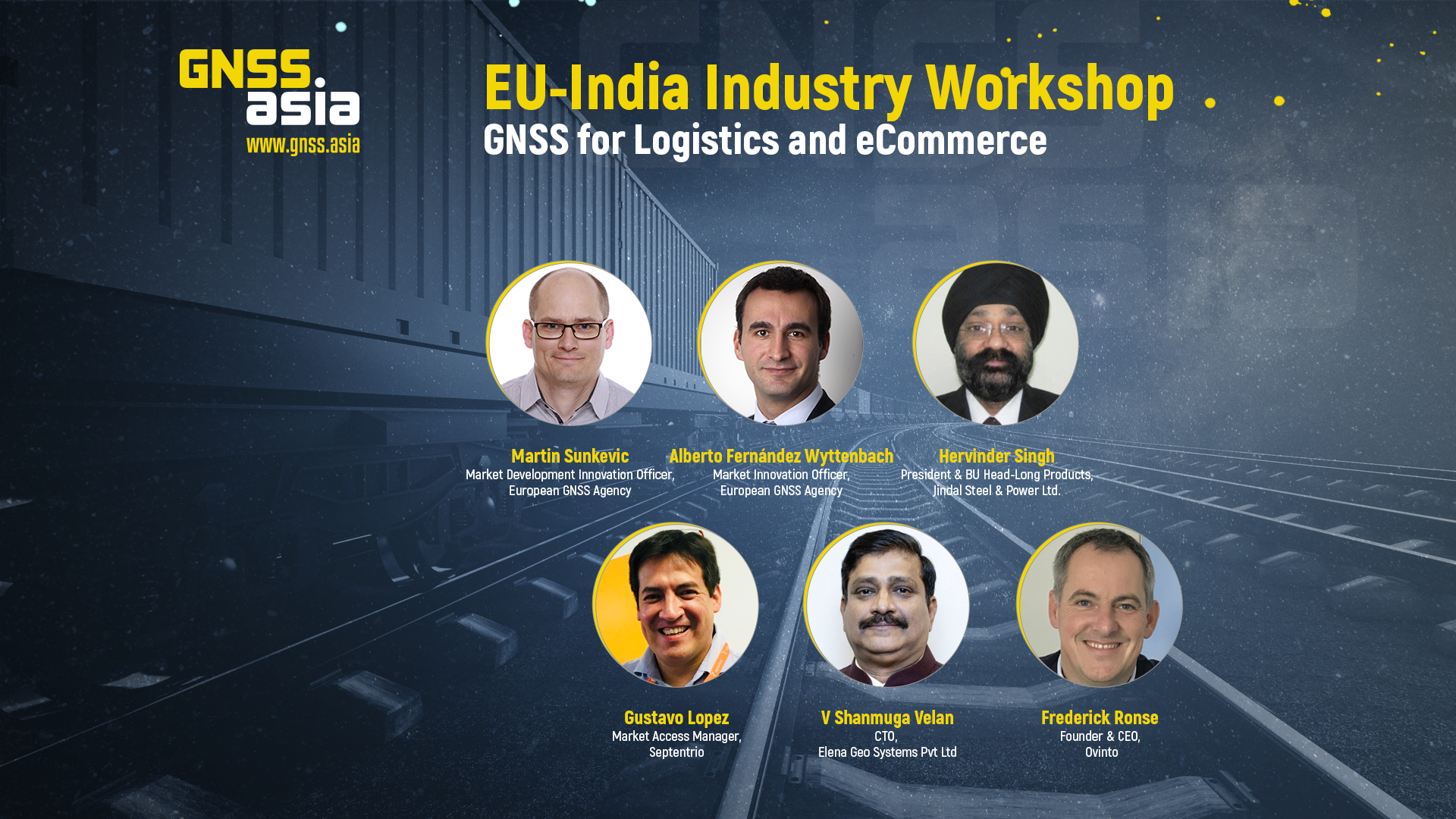Flashback to the EU-India Online Workshop on GNSS for Logistics & eCommerce


The article summarises the highlights of the recent online event organised by GNSS.asia – EU-India Online Workshop
Outline of the event
On 18 September, GNSS.asia organised a webinar which brought together GNSS experts from various regions and organisations. The European GNSS Agency (GSA) was accompanied by Septentrio and Ovinto who joined the panel on behalf of the European GNSS industry. Jindal Steel together with Elena Geo Systems brought the perspective of the Indian GNSS industry.
The benefits of Galileo
The conversation was started by Mr Martin Sunkevic and Mr Alberto Fernandez-Wyttenbach from the GSA who outlined the general relevance of GNSS technologies on a global scale. Three key benefits of Galileo – the European GNSS system – were brought into focus.
- The addition of an extra constellation means access to a larger number of visible satellites which results in a higher-accuracy positioning data.
- The use of multiple frequencies brings the second benefit in the form of enhanced robustness against mass-market jammers or improved accuracy coming from substantial removal of the ionosphere error.
- Lastly, the issue of multipath effects could be reduced by up to 50% through the employment of signal in E5 band with advanced code modulation.
In addition to the usual features, Galileo is expected to roll out a set of brand-new functionalities within the upcoming two years. This includes authentication services, namely E1 Navigation Message Authentication and a high accuracy service based on PPP transmission in the Galileo E6b signal.
GNSS for logistics and eCommerce
With millions of tons of goods being transported around the globe, there is a high demand for a variety of GNSS-based applications.
- Container positioning allows to precisely track the locations of the shipment units and use this information for optimising the supply chain, from improving the allocation of containers to monitoring demand and planning shipments based on the observed travel times.
- Corridoring and geofencing also play important roles as they allow to enhance the security levels by establishing an automatic alert system that notifies of shipping errors or thefts.
- Another GNSS value-added comes in the form of an asset management functionality that enables georeferenced cargo status monitoring of such parameters as humidity and temperature as well as detection of leakage or any potential damage.
- Moreover, GNSS will be the key enabler for a number of novel solutions including automated operations and logistics hubs, automated land, maritime, and airborne fleets, as well as geo-marketing and advertising.
India’s market in focus
Mr Krishna presented recent statistics on the state of logistics and eCommerce markets in the country showcasing significant trends. India’s logistics market is projected to have a year-on-year growth of 10.5% over the period of 2019-2025, and in 2019, the country was ranked second in the Agility Emerging Markets Logistics Index. At the same time, India’s eCommerce market is expected to experience a cumulative growth of 1200% by 2026, making it the fastest-growing in the world.
Challenges to tackle
Naturally, due to certain specific characteristics, the Indian freight transportation market presents unique challenges and demands appropriate solutions. Mr Krishna pointed out that there is an evident lack of integration in transportation networks, IT, as well as warehousing and distribution facilities in addition to the prominent shortage of skilled sector-specific manpower. Together, these two factors result in the poor industry-wide efficiency levels, with considerable losses from damage and deterioration of stock, especially in the perishable goods sectors. In addition to the more commonplace use of refrigeration during transportation and storage, smart logistics approaches have to be put in place, heavily driven by positioning data.
Further confirmation of the pressing needs for location-based solutions was provided by Mr Singh who presented the situation from the perspective of one of India’s major metallurgical firms Jindal Steel. He used the example of trucks which once leave factory premises are challenging to track without the help of GNSS. The need for such monitoring is multifaceted and is rooted in an attempt to avoid various potential issues and abuses. For example, by tracking the vehicles, it is possible to reduce the instances of infiltration – a situation when without the awareness of the company, trucks are taken off the planned route and driven to a completely different destination. Generally, two use case groups could be identified: asset security – tracking highly valuable assets, and asset utilisation – reducing unauthorised use of resources and promoting higher levels of efficiency.
When it comes to the general needs for GNSS-based services, Mr Velan highlighted the importance of reliability both in terms of device build quality and uninterrupted service, but also stressed the existence of a high-cost sensitivity and a stark preference for one-time purchase as opposed to recurring payments. With regards to the use of Galileo, in particular, Mr Singh stressed the current lack of market penetration stemming from a more fundamental issue – low national awareness of the technology. With this in mind, he suggested taking the approach of end-to-end turnkey implementation of the complete solution for the development of trust and smoother adoption of the technology.
The European take
This perspective was further elaborated by two European firms active in the market – Septentrio and Ovinto. Mr Lopez discussed the major trends in the logistics industry: the strife towards automatisation, connectivity, and accurate localisation, as well as the increasing usage of blockchain and wearables. He also dived deeper into the underlying needs of the market, suggesting position, orientation, and security as the three cornerstones of any GNSS application. The second factor is particularly important for achieving the abovementioned highly desired automation of processes. Mr Lopez illustrated his argument with a vivid example of a warehouse where all forklifts and personnel are supplied with GNSS equipment which sends the collected data to the control centres. Such precise monitoring of the workspace is crucial not only for guaranteeing the integrity of the stock but also for ensuring the highest degree of safety for every worker on site.
The role of automation was furthered by Mr Ronse who underpinned the extreme dependence of the rail sector on the manual work and the importance of GNSS for overcoming the issue. He emphasised the benefits of automation, namely fast and significant efficiency gains, increased capacity, and enhanced customer satisfaction. One particularly crucial novel GNSS application is predictive maintenance, where as opposed to the traditional reactive maintenance, carriages undergo technical upkeep not when something brakes but rather after a certain number of usage cycles. To make his point more tangible, Mr Ronse quoted the results of a study which suggested 30% operational costs savings from the switch to predictive maintenance.
Conclusion
The event reinforced the immense potential of the European GNSS technologies – including our very own Galileo constellation – for logistics and eCommerce in India. It is clear that India’s current storage and transportation challenges could be addressed by GNSS-based solutions in, for instance, asset tracking and fleet management, thereby increasing efficiency and safety. Such solutions are available in Europe, from technology providers such as Septentrio and Ovinto who offer state-of-the-art receivers and applications in this particular market domain. The extra benefits of Galileo (e.g. enhanced accuracy and OS-NMA) could make an additional difference for Indian users. Nevertheless, further regional awareness is required to enhance its uptake, as mentioned by Elena Geo Systems.
When it comes to the audience, over sixty participants have joined the webinar, and according to the subsequent poll, more than 90% of respondents have genuinely enjoyed the event.
In case you have any questions or wish to be connected to one of our speakers, please contact us at hello@gnss.asia.
If you did not have the opportunity to watch the webinar live and would like to learn more, the recording of the event is at your disposal here.
Feel free to share your feedback with us on social media.